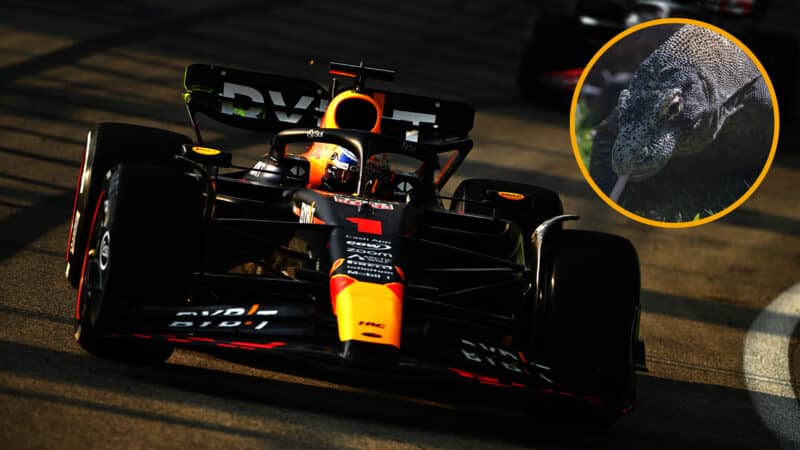It’s a peculiar situation only provided by the streets of Marina Bay but the Singapore locals could end up being a critical obstacle to overcome during practice, qualifying and, more importantly, during Sunday’s Grand Prix.
There were several sightings of the commonly found monitor lizard over last year’s Singapore GP weekend, as they scuttled across the circuit while drivers fought to complete their first laps of the weekend during FP1. There were some near misses — Charles Leclerc, Lando Norris and Verstappen all slowing and swerving — but one lizard wasn’t so lucky as it met Fernando Alonso‘s Aston Martin.
Similarly to the groundhogs of Montreal — which add an additional hazard to Canadian GP — the lizards themselves are protected by Singapore’s Wildlife Act, making it impossible for the reptiles to be removed from the circuit for the race weekend. So, with ‘Godzilla Jr’ here to stay, here’s everything you need to know about the Singapore locals and their possible effect on this weekends grand prix:
What kind of lizards are found at Singapore GP?
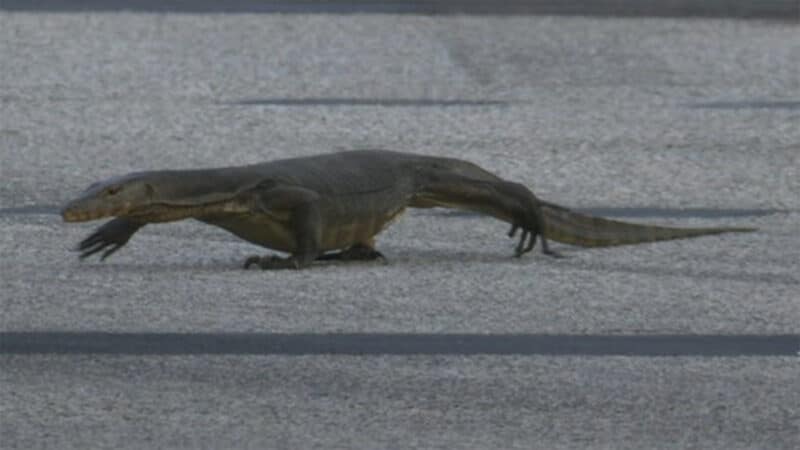
Several monitor lizards were spotted during FP1
X/F1
The hot and humid nature of Singapore makes it a natural home for reptiles such as lizards, with seven different species found across Marina Bay. The most notable are the monitor lizards, often seen during the intermittent running of free practice on Friday and Saturday, which can grow up to anywhere between three inches and ten feet in length.
Drawn to warmth, lizards can be frequent on-track visitors as the asphalt retains the day’s heat, resulting in dangerous moments for both man, machine and monster. However, as the race is held at night, encounters are less frequent than in the earlier practice sessions, as monitor lizards return to their burrows.
What will happen if a lizard appears on track at the Singapore GP?
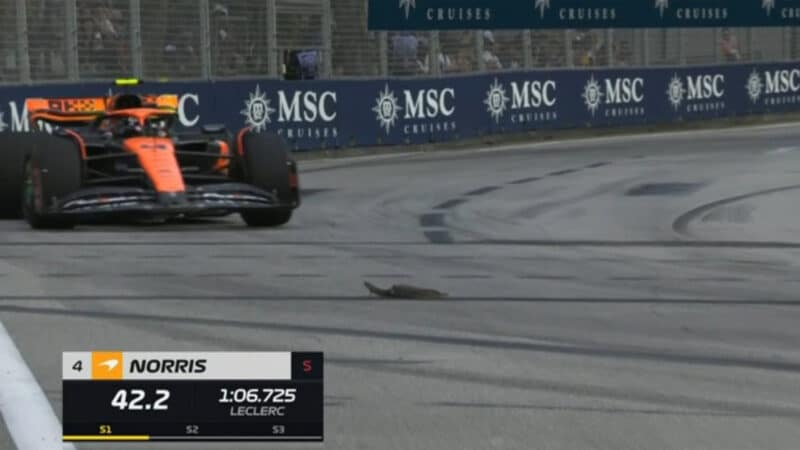
While most lizards are easily avoided, some are not so lucky when coming to face to face with an F1 car
Sky Sports F1
In an ideal world, the lizards of Singapore and speeding F1 cars will stay a safe distance from one another for the entire 2024 race weekend. But, should an on-track invasion happen during qualifying or the grand prix, there are several possible outcomes.
Should a lizard decide to camp out on track during qualifying, the session would most likely be yellow flagged while the Singapore local is moved on by stewards. There would most likely be a similar reaction during Sunday’s race.
But, if more on-track contact were to occur, it could change the results of the race dramatically. Colliding head-on with one of Singapore’s biggest reptiles would almost certainly cause damage to the front wing, tyres or even the suspension of an F1 car — forcing drivers into extra pitstops and losing precious time. However, swerving in avoidance could be riskier if the field is running close together.
Ultimately, if local wildlife poses too much of a danger, the race could be red flagged.
Have drivers collided with Singapore lizards in the past?
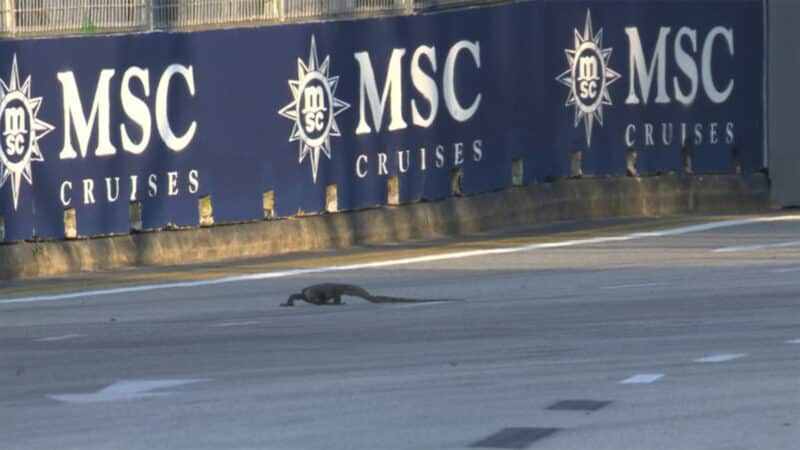
2023 is not the first time ‘Godzilla’ has invaded Singapore
YouTube
‘Godzilla’ has invaded the Marina Bay circuit on multiple occassions in the past. During practice for the 2016 Singapore Grand Prix, a young Max Verstappen came narrowly close to colliding with a “massive” lizard which wondered across the circuit ahead of his Red Bull.
After warning his team on the radio, his long-term race engineer Gianpiero Lambiase replied: “Face to face with Godzilla then mate?”
Fast-forward to 2023, Verstappen had another near miss — although this time around, the on-track visitor was “much smaller”.
“Maybe Godzilla had a kid?” Lambiase joked.
While the Aston Martin of Fernando Alonso went undamaged after a collision with ‘Godzilla Jr’ during FP1 last year, other drivers may not be so lucky, causing chaos to quickly unfold over the race weekend.
Birds, bees and other wildlife encounters at F1 grand prix
The lizards of Singapore are just one of many parts of wildlife F1 must co-exist with during the series’ journey around the globe — some meetings ending better than others.
At the 2023 Canadian Grand Prix, several drivers had their annual run in with the indigenous groundhog — a small rodent which has an unfortunate habit of running across the Circuit Gilles Villeneuve on race weekends. Nicholas Latifi‘s Williams was the last car to make mortal contact with one in 2022, the driver swearing repeatedly and asking the team to check his front wing while on a qualifying run in FP3.
Other animals have been slightly more fortunate.
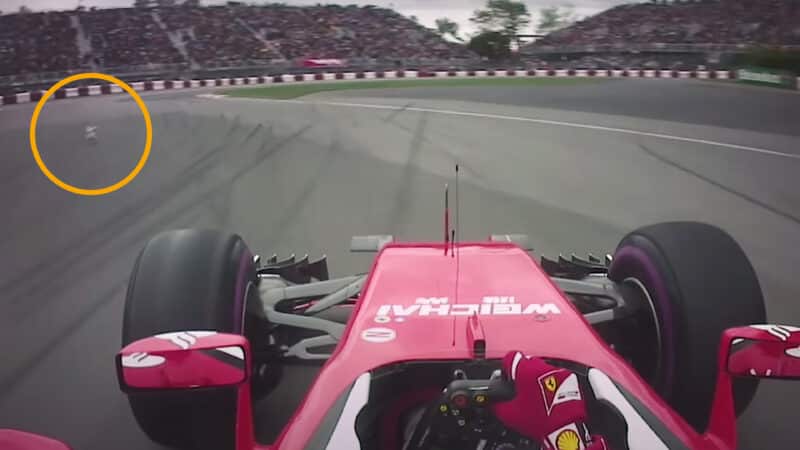
Vettel came face-to-face with “suicidal birds” in 2016
F1 YouTube
Six years earlier, during the 2016 Canadian Grand Prix, a pair of “suicidal seagulls” prevented Sebastian Vettel from claiming victory over Lewis Hamilton — the birds sat perfectly on the racing line, forcing the German to lock up and run wide through Turn 1 to avoid them. The former rivals joked about the incident after the race, Hamilton claiming: “It was all planned”.
Vettel’s close wildlife encounters continued throughout his career. He raced alongside rogue dogs in India in 2011, almost hit a bird during qualifying for the German Grand Prix in 2019 and finally finished a disappointing twelfth at Imola in 2020 after having a run-in with the circuit’s supposed ‘lucky cat’.
“I don’t like cats” the German said.
